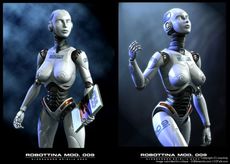
Joaquin Phoenix in 'Her'
In a previous blog I examined agalmatophilia (in which individuals derive sexual arousal from an attraction to (usually nude) statues, dolls, mannequins and/or other similar body shaped objects). Some scholars claim that robot fetishism is another type (or at least an extension) of agalmatophilia. Robot fetishism is often referred to as ASFR (i.e., alt.sex.fetish.robots, based on the name of a now defunct newsgroup) or technosexuality.
It refers more specifically to those individuals who derive sexual pleasure and arousal arising from humanoid or non-humanoid robots. Last year, technosexuality received a lot of press coverage following the release of Spike Jonze’s film Her, about a man named Theodore Twombly (played by Joaquin Phoenix) who develops a relationship with an intelligent computer operating system with a female voice and personality. The original ASFR manifesto stated:
“The alt.sex.fetish.robots (ASFR) newsgroup is dedicated to the discussion of the concept of sex with or sexual attraction to robots and robot-like beings. This can range from metallic, non-humanoid machines to humanoid androids. Discussions can deal with specific fantasies, fiction relating to the topic and connected ideas like people behaving like/turned into human mannequins, dolls, toys, and other hypnosis and mesmerism fantasies that involve the mechanical/monotone response that appeals to the members”
Techno-sexuality can be fantasy-based arousal where the robot fetishist merely thinks about sexual scenarios involving robots and/or can involve sexual activity with people dressed in robot costumes. (Just as an aside, if you are a music fan, check out Frank Zappa’s concept LP, Joe’s Garage that examined robot fetishism).
The sexual arousal may be heightened the more that the person imagined or dressed as a robot sounds and acts in a robotic-like manner. Those into this fetish call themselves ‘ASFRians’ and/or ‘technosexuals’ and some of these individuals like to imagine removing skin or bits of the body to reveal electronic circuitry (so you can imagine that they get turned on by everything from the Six Million Dollar Man through to The Terminator).

Robot fetishism can sometimes include other fetish variants, most notably transformation fetishes where the individuals get sexually excited by imagining themselves turning into a robot. These are conceptually similar to those in the Furry Fandom who get sexually excited by imagining themselves transform into an animal or animal hybrid. Similar to furries, robot fetishism could be viewed as another form of erotic anthropomorphism. It is also claimed that when transformation and/or role-playing are involved, the activity may be viewed as a form of erotic objectification. There are also similarities to mechanophilia (i.e., sexual arousal from cars or other machines and sometimes referred to as ‘mechasexuality’).
According to the ASFR websites that I have visited, techno-fetishists comprise two distinct but not necessarily mutually exclusive types of techno-sexual fantasy. As one online essay on agalmatophilia at the Stupid My Cupid website claims:
“The first of group is simply based off of a desire to have a ready-made android or gynoid [female robot] partner that is desired for sex, companionship, or any combination of the two. The main distinguishing feature of this type is that the android is a completely artificial "built" and manufactured solely to fulfill the desires of its owner. The second type of fantasy is referred to as transformation. This involves a human who is either willingly or unwillingly turned into an android. That person can be either oneself or one's partner, or sometimes both. It is usually the process of transformation that is the focus of this fantasy. Many people in the ASFR community prefer either one or the other. In some cases, this preference is very strong and divisive within the community. People may even be repulsed by the behaviors of the opposite group. In other cases, there is equal appreciation for built and transformation”.
A survey carried out on the Fembot Central website among 318 technosexual members and that 66% of ASFRians had a preference for built robots while the others preferred transformation (18%) or some combination of both (16%). In her 2000 book Deviant Desires, Katharine Gates also revealed that some techno-fetishists do not like synthetic partners at all, and prefer their fantasies to involve humans dressed as robots as part of fantasy sex play.
The expression of technosexuality is somewhat limited as it can only be acted upon in a few ways (i.e., masturbatory fantasy and/or sexual role-play). As a consequence, a large market for techno-sexual art has developed that caters for (and as an enabler) robot fetishism (i.e., it can help sexually stimulate ASFRians). Visual media is also important for techno-fetishists. As highlighted online:
Scene from 'Metropolis' “The film ‘Metropolis’ also explores this fetish. In this film, the mad inventor Rotwang kidnaps the heroine Maria. He's created a robot to be a replacement for a woman he loved, but it needed a soul so he imprints the image of Maria onto his Robot. The scene itself is filled with the trappings of the mad scientist film before there ever was a visualized Dr. Frankenstein's lab. There seems to be a reoccurring theme with mad scientists creating robots or dolls that come to life. There is the Bride of Frankenstein. There are a number of pulp serials full of hypnotized femmes such as Star Trek, The Twilight Zone, and My Living Doll…Of course we still see the Frankenstein Complex in such creations such as Blade Runner, Westworld, The Stepford Wives, and Star Trek, but now there is an added tone of eroticism”. 

Scene from 'Metropolis'
“The film ‘Metropolis’ also explores this fetish. In this film, the mad inventor Rotwang kidnaps the heroine Maria. He's created a robot to be a replacement for a woman he loved, but it needed a soul so he imprints the image of Maria onto his Robot. The scene itself is filled with the trappings of the mad scientist film before there ever was a visualized Dr. Frankenstein's lab. There seems to be a reoccurring theme with mad scientists creating robots or dolls that come to life. There is the Bride of Frankenstein. There are a number of pulp serials full of hypnotized femmes such as Star Trek, The Twilight Zone, and My Living Doll…Of course we still see the Frankenstein Complex in such creations such as Blade Runner, Westworld, The Stepford Wives, and Star Trek, but now there is an added tone of eroticism”.
Allison de Fren published an interesting paper in a 2009 issue of the journal Science Fiction Studies. Her essay examined techno-fetishism, particularly in relation to the machine woman, by studying the technosexual community. Her paper argued that A.S.F.R. is less about technology in general, or the artificial woman in particular. To de Fren, techno-fetishism is:
“…a strategy of denaturalization that uses the trope of technological ‘programming’ to underscore subjecthood. Like the trope of "hardwiring" used within cyberpunk as a signal of the constitution of bodies and identities in relation to networked systems of control and power, ‘programming’ serves as a metaphor for the biological and cultural matrices within which desire is articulated and pursued. ASFRians experience pleasure and agency through, in a sense, hacking the system, the visual indicators of which often take the form of a female android who has run amok, an image that is typically read as a threat”.

As far as I am aware, there is no psychological research on robot fetishism beyond theoretical essays. While of interest, it would be really useful to know how big the techno-sexual community is and what the motivations are in engaging in such behaviour (submission/dominance is an obvious theme but there’s no literature to confirm or disconfirm such speculation. I’ll leave you with a quote by Dr. Glenda Shaw-Garlock in Human-Robot Personal Relationships, who probably didn’t have robot fetishists in mind when she wrote it, but which has great resonance with this topic:
“Today, human and sociable-technology interaction is a contested site of inquiry. Some regard social robots as an innovative medium of communication that offer new avenues for expression, communication, and interaction. Other others question the moral veracity of human-robot relationships, suggesting that such associations risk psychological impoverishment. What seems clear is that the emergence of social robots in everyday life will alter the nature of social interaction, bringing with it a need for new theories to understand the shifting terrain between humans and machines”
References and further reading
de Fren, A. (2009). Technofetishism and the Uncanny Desires of A.S.F.R. (alt.sex.fetish.robots), Science Fiction Studies, 36, 404-440.
Gates, K. (2000). Deviant Desires: Incredibly Strange Sex. New York: RE/Search Publications.
Gore, E. (Undated). The technosexuality, Pygmalionist and mind control fetish FAQ 3.0. Located at: http://www.p-synd.com/winterrose/technosexuality.html
Shaw-Garlock, G. (2011). Loving machines: Theorising human and sociable-technology interaction. Human-Robot Personal Relationships, Lecture Notes of the Institute for Computer Sciences, Social Informatics and Telecommunications Engineering, 59, 1-10
Strohecker, D.P. (2011). Robot Fetishism, Synthetic Partners, and Phallogocentrism, The Society Pages, July 22. Located at: http://thesocietypages.org/cyborgology/2011/07/22/robot-fetishism-synth…
Stupid My Cupid (2010). Agalmatophilia: Love in the age of silicon. May 20. Located at: http://stupidmycupid.blogspot.co.uk/2010/05/what-is-agalmatophilia-agal…




